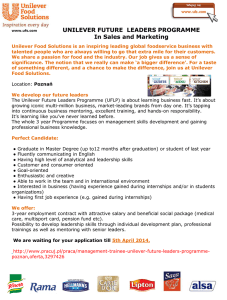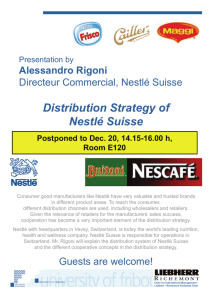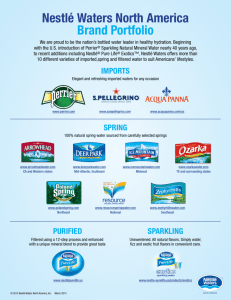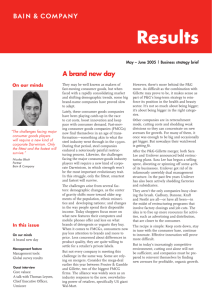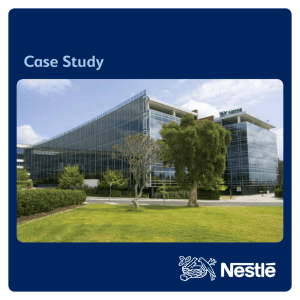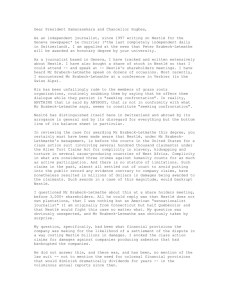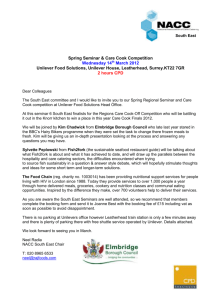Feeding Financial Markets:
advertisement
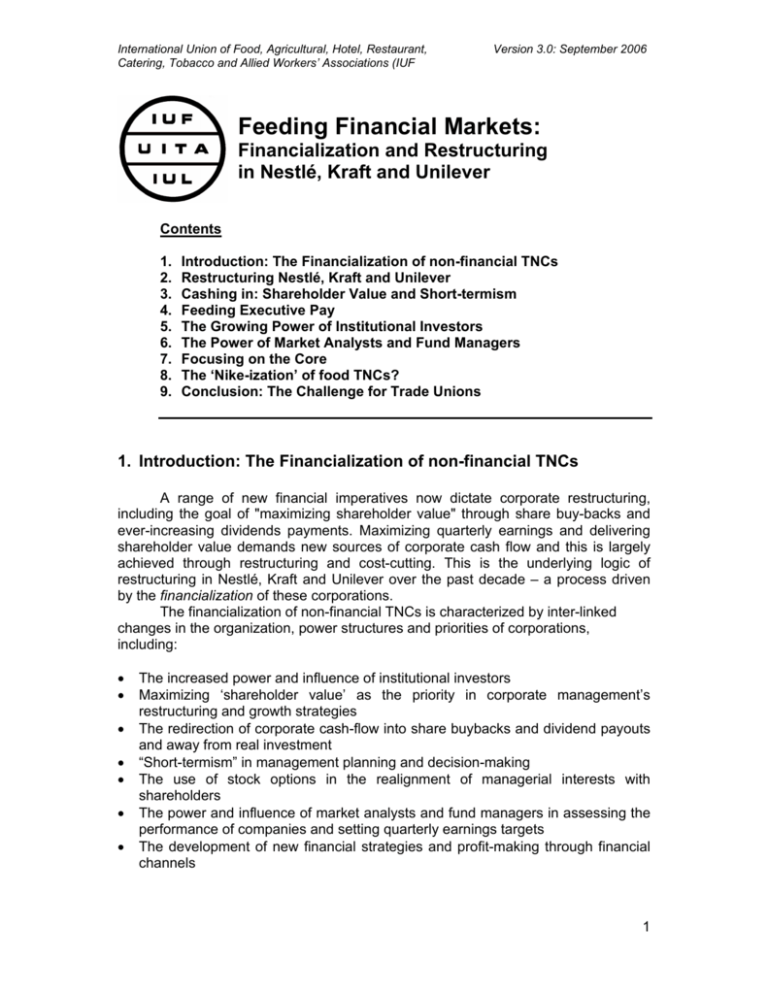
International Union of Food, Agricultural, Hotel, Restaurant, Catering, Tobacco and Allied Workers’ Associations (IUF Version 3.0: September 2006 Feeding Financial Markets: Financialization and Restructuring in Nestlé, Kraft and Unilever Contents 1. 2. 3. 4. 5. 6. 7. 8. 9. Introduction: The Financialization of non-financial TNCs Restructuring Nestlé, Kraft and Unilever Cashing in: Shareholder Value and Short-termism Feeding Executive Pay The Growing Power of Institutional Investors The Power of Market Analysts and Fund Managers Focusing on the Core The ‘Nike-ization’ of food TNCs? Conclusion: The Challenge for Trade Unions 1. Introduction: The Financialization of non-financial TNCs A range of new financial imperatives now dictate corporate restructuring, including the goal of "maximizing shareholder value" through share buy-backs and ever-increasing dividends payments. Maximizing quarterly earnings and delivering shareholder value demands new sources of corporate cash flow and this is largely achieved through restructuring and cost-cutting. This is the underlying logic of restructuring in Nestlé, Kraft and Unilever over the past decade – a process driven by the financialization of these corporations. The financialization of non-financial TNCs is characterized by inter-linked changes in the organization, power structures and priorities of corporations, including: • • • • • • • The increased power and influence of institutional investors Maximizing ‘shareholder value’ as the priority in corporate management’s restructuring and growth strategies The redirection of corporate cash-flow into share buybacks and dividend payouts and away from real investment “Short-termism” in management planning and decision-making The use of stock options in the realignment of managerial interests with shareholders The power and influence of market analysts and fund managers in assessing the performance of companies and setting quarterly earnings targets The development of new financial strategies and profit-making through financial channels 1 International Union of Food, Agricultural, Hotel, Restaurant, Catering, Tobacco and Allied Workers’ Associations (IUF) September 2006 The financialization of non-financial corporations means that decisions concerning the restructuring, downsizing, closure or relocation of specific workplaces are determined by financial imperatives that replace conventional concerns with productivity and profitability. The financialization process has an immediate and severe impact on trade unions, including: • • • • • • • breaking the link between productivity, wages and profit which serves as the foundation of workplace collective bargaining so that even plants with high productivity & profitability face restructuring, job cuts or closure undermining employment security through accelerated restructuring, including increased reliance on outsourcing, casualization and co-packing in addition to layoffs undertaken for accounting purposes (reducing payroll as a component of cash flow) declining long term productive investment as "short-termism" increasingly dominates management strategies demands of “short-termism” and excessively high rates of return (15-25%) further increases downward pressure on wages & benefits and intensifies restructuring rapid changes in ownership, adding to employment instability and continuous restructuring while disrupting collective bargaining relationships creating complex employment relationships that obscure the real employer, or permit new owners to evade employer responsibility (notably in the case of private equity buyouts) generalized financial instability and insecurity The implications of the financialization process for trade union organizing and collective bargaining cannot be overstated. 2. Restructuring Nestlé, Kraft and Unilever Over the past decade financialization has directly shaped the corporate restructuring strategies of the world’s three largest food manufacturers: Nestlé, Kraft and Unilever.1 At every step of this restructuring CEOs and CFOs of Nestlé, Kraft and Unilever have tried to satisfy financial markets by meeting the projected estimates of market analysts and fund managers, while generating as much corporate cash flow to boost shareholder value. Kraft’s Sustainable Growth Plan involved the elimination of 6,000 jobs and the closure of 20 plants from 2000 to 2004. In the second phase of this restructuring announced in February 2006, another 8,000 jobs will be cut and another 20 plants will be closed.2 Under Unilever’s Path to Growth Strategy some 500 plants (including 305 food manufacturing plants) will be reduced to just 150 key sites around the world, with another 200 sites producing local products. As part of this consolidation drive the company’s portfolio of brands has been reduced from 1600 to just 400 and 150 factories were closed in the first phase (2000-2004). In the current phase, in addition to selling off its European frozen food division to the private-equity fund, Permira, another 100 plants are scheduled to be closed.3 So far this Path to Growth Strategy has involved the destruction of 20,000 jobs and generated cash flow of €30 billion – the bulk of which has gone into raising dividends. The target is raise shareholders’ 2 International Union of Food, Agricultural, Hotel, Restaurant, Catering, Tobacco and Allied Workers’ Associations (IUF) September 2006 rate of return on capital from 12.5% to 17% by 2010.4 Nestlé’s global restructuring (described to investors as the “Nestlé Model”) generated cash flow of US$1.5 billion from 2001-2003, meeting financial market expectations. From March to October 2003 the mere promise of further restructuring to create value for shareholders in 2005-2006 led to a 28% jump in Nestlé share prices.5 From 2003-2005 another US$2.5 billion was generated from restructuring, allowing Nestlé to launch its first share buyback in 2005 with CHF 1 billion and maintain the company's AAA rating (the highest). Nestlé's 2004 end of year report stated that future buy-back programmes were planned depending on “market conditions”. On 23 February 2006 Nestlé announced a 21% increase in net profits and a 12.5% dividend payout, together with the allocation of CHF 1 billion for a new round of share buy-backs in addition to the CHF 3 billion share buy-back launched only three months earlier. As with Kraft and Unilever, the Nestlé Model involves extensive jobs destruction through closures, downsizing, casualization and outsourcing. Outsourcing is in fact a major element of Nestlé’s global restructuring, with all of its 500 plants worldwide undergoing a process of redefining “core” versus “non-core” activities. "Non-core" activity is being outsourced. Kraft and Unilever have also increased casualization and outsourcing in those plants they have not closed or sold. The second phase of Unilever’s restructuring under its Path to Growth Strategy involves increasing outsourcing of production from 15% to 25%.6 3. Cashing in: Shareholder Value and Short-termism In a situation of market saturation the allocation of corporate funds for productive investments is seen as a high risk by investors. Faced with aggressive shareholder activism and warnings from Wall Street, company executives have found it simpler to use this money to buy back shares, pay out high dividends and acquire other companies.7 Since these executives also hold shares and stock options as part of their remuneration, they benefit personally from this redirection of funds into feeding financial markets. A recurrent theme in all of the company documents and presentations to investors by executives from Nestlé, Kraft and Unilever since 2000 is the priority given to maximizing shareholder value. Shareholder value serves not only as a justification for restructuring, spin-offs, closures or acquisitions. It is a language that analysts expect from company executives – a mantra that must be repeated every quarter. It also represents a political response by executives to the constant threat (real or potential) of criticism, activism and other pressures from shareholders. Every move that executives make must be defended and explained in terms of the immediate, easily quantifiable benefit to shareholders. Shareholder concern for profitability and good rates of return is certainly nothing new. But what has changed is the expected rate of return (currently more than 15% and rising) and the perceived source of potential profitability and how that potential is realized. This is illustrated by the changing role of corporate debt. Shareholders traditionally saw rising levels of debt as a risk, raising doubts about the viability of a firm. Now firms are criticized for not maximizing their debt levels and are expected to unlock shareholder potential through accumulating debt. There is a powerful shareholder demand for debt-financing of any new investment since real 3 International Union of Food, Agricultural, Hotel, Restaurant, Catering, Tobacco and Allied Workers’ Associations (IUF) September 2006 investment is now viewed as high risk with a low rate of return. Thus unlocking shareholder value has become a euphemism for debt and restructuring. For the past six years Kraft Foods executives have explained all aspects of restructuring as a means of unlocking shareholder value. In October 2005, for example, Altria announced plans to “unlock shareholder value” in Kraft by spinning it off into a separate company. Presentations to investors explicitly referred to the ongoing mass lay-offs of 14,000 workers and closure of 40 plants in its 2000-2008 restructuring as a key element in unlocking this value.8 When Nestlé’s record profit of US$6.1 billion was reported in February 2006, a 21% increase in earnings over the previous year, Nestlé CEO Brabeck announced increased dividend payouts and another CHF 1 billion in share buy-backs: “The enhanced dividend proposal and the share buyback demonstrate Nestlé’s commitment to creating long-term, sustainable value for our shareholders.”9 A crucial element in this new corporate logic and language is the changed function of “longterm.” In the context of financialization and increasingly impatient capital, the longterm is continually shrinking. For private equity funds, long-term means only five to seven years.10 Some private-equity funds have recently begun to describe their long-term horizon as 3-5 years! Unilever’s Path to Growth was not in fact about growth in real terms (that is, in terms of increasing the value of real assets) but of increasing dividend payments to shareholders and boosting share prices. In September 2004 it was reported that after “….seven quarters of disappointing performance, it needs to regain credibility with investors.”11 In an attempt to regain credibility Unilever executives repeatedly stressed a commitment to maximizing shareholder value. In his presentation to Morgan Stanley on 3 November 2004, Chairman of Unilever NV, Antony Burgmans, listed three global dimensions of Unilever: 1) scale and geographic reach; 2) track record and control of costs and capital; 3) commitment to shareholder value. Throughout the presentation this is repeated, with the concluding bullet point to allay any fears: “Unilever fully committed to driving shareholder value.”12 In concrete terms Unilever’s Path to Growth Strategy in 2000-2004 generated €16 billion cash-flow and sets a 2005-2010 target of €30 billion – all geared to boosting shareholder value. Returns on invested capital will be raised from 12.5% in 2003 to 17% in 2010.13 The financial press reports on Unilever’s desperate attempts to prove that it is in fact prioritizing and maximizing shareholder value compelled executives to adopt a strategy that would translate better for analysts and feed financial markets: Unilever is scrapping its controversial sales and margin targets and replacing them with broad objectives to increase cash-flow and returns to shareholders in dividends and share buybacks over five years. The shift in focus, which was accompanied by a good set of profits, was greeted warmly by a stock market that has recently punished the Anglo-Dutch multinational for failing to fulfill its promise of revenue growth.14 The result? Shares of Unilever PLC in London and Unilever NV in Amsterdam rose as several securities analysts were quoted as saying that Unilever shares were finally starting to “look good”. 4. Feeding Executive Pay 4 International Union of Food, Agricultural, Hotel, Restaurant, Catering, Tobacco and Allied Workers’ Associations (IUF) September 2006 All of this looked good for company executives too, since the shares and options that form part of their remuneration make them shareholders too. Maximizing shareholder value is of direct, personal interest to the top executives of Nestlé, Kraft and Unilever. In addition to CHF 17.5 million in salaries for 2004, Nestlé’s executive management received CHF 7 million in shares and CHF13 million in stock options. While cash remuneration remained the same from 2003 to 2004, the value of shares increased 58% and share options increased 99%, with these executives holding 77,156 shares and 562,159 options at the end of the fiscal year.15 At Unilever stock options for executives are tied to performance: shareholder returns must be in the top third of a group of 20 companies including Nestlé, Procter & Gamble and Coca-Cola. In 2002 Unilever co-Chairman, Niall Fitzgerald, stated that: “Our philosophy is if we are capable of beating them in the marketplace, then we are capable of beating them in shareholder value and you will be rewarded accordingly.”16 Unilever also started issuing stock options to its executives as part of its expansion in the US where they were “forced to play by American rules.”17 These rules soon became global and were applied to the company as a whole. As part of Path to Growth a Reward for Growth remuneration scheme for management extended share options to 7,000 managers around the world.18 When Fitzgerald left Unilever in 2004 he received a ₤1.2 million salary payment. Share sales boosted this to ₤3.7 million, plus another ₤3 million added to his pension for a total ₤17 million.19 In the following year Unilever CEO Patrick Cescau earned €2.5 million and the CFO earned €1.43 million, plus an undisclosed number of share options. This led to a shareholder backlash. Within a year the Unilever CEO’s salary rose 43% and the CFO’s salary rose 30%. In contrast share prices rose 13% and dividend payouts rose 6% for Amsterdam-listed NV shares and 5% for London-listed PLC shares. This disparity was seen as evidence that executives were not prioritizing shareholder value – creating even greater pressure from institutional investors to generate cash-flow and channel this into dividends and share buybacks (and not simply to boost executive salaries). Selling off the company’s European frozen foods division to a private-equity fund was a key element in management’s response to this pressure. It is also important to recognize that these new financial imperatives are not limited to the highly industrialized countries. The drive to maximize shareholder value and satisfy financial markets also dictates corporate restructuring policies in the South. This is illustrated by Nestlé's promise of short-term shareholder gains to justify the sell-off of its Indian Samhalka plant that produces ‘Pure Life’ brand bottled water. According to the head of Nestlé India, Carlo Donati, “The plant produces other products from the Nestlé stable, but we are looking to sell off the machinery related to the water business, to enhance shareholder value.”20 Further closures and selloffs announced at the beginning of 2006 were justified in the same way: “Nestlé continuously reviews its product portfolio to maximize shareholder value on a longterm basis. Discontinuation of Chocostick, Butter and Dust Tea is part of the process.”21 Of course long-term in this context means 3 to 5 years! 5. The Growing Power of Institutional Investors In most countries with today institutional investors, especially mutual funds, 5 International Union of Food, Agricultural, Hotel, Restaurant, Catering, Tobacco and Allied Workers’ Associations (IUF) September 2006 pension funds and insurance companies, now control a greater proportion of publicly traded shares. Unit holders in mutual funds and pension funds do not own shares in the companies in the fund’s portfolio - these shares are held by fund trustees. Since the decision to invest in financial markets is divorced from where to invest it, there is no interest in a particular company’s survival. Shareholder value must therefore be understood in terms of the interests and expectations of institutional investors (and not the unit holders who have invested in these funds). The changes in Nestlé, Kraft and Unilever over the past decade are associated with the steady growth in the power and influence of institutional investors.22 Two-thirds of Nestlé shares are in portfolios of pension funds.23 This is a relatively recent phenomenon that arises out of Nestlé’s “de-regulation” of its shareholding arrangements in November 1988 when management relaxed restrictions on foreign investors. Until then Nestlé’s registered shares could only be held by domestic investors subject to criteria for acceptability for registration, which essentially meant management approval. This restriction was removed, allowing foreign investors to trade freely in all three kinds of shares (bearer shares with no voting rights were later abolished in 1993). The move was intended to raise capital and “improve the firm’s image internationally.”24 The image problem stemmed from the fact that: “Nestlé had been repeatedly criticized for attempting to take over firms in countries outside Switzerland while being protected from foreign acquisition.”25 Changes to allow foreign shareholders to own registered shares led to a sudden increase the capitalized value of the company, increasing by almost 22%.26 At the same time the decision to allow foreign investors to hold vote-bearing shares meant that management had “opened the gates for potential takeovers from abroad”.27 Foreign ownership of Nestlé shares immediately jumped from 15% to 45%.28 To secure support for changes allowing foreign shareholders to hold registered shares with voting rights, Nestlé executives had to assure the company's traditional shareholder base (concentrated in Switzerland, with 30% held by French nationals) that a foreign investor would not be allowed to accumulate enough shares for a hostile takeover. Together with the amendment allowing foreign ownership of registered shares another amendment was therefore made to restrict voting rights to 3% of voting equity, regardless of the size of an investor’s holdings. This restriction on voting rights, however, became a focus of growing tension. As the shareholdings of institutional investors grew so too did demands that this ownership be expressed in voting rights. Moreover, such restrictions were interpreted by market analysts as a constraint on shareholder value. As Swiss pension funds began seeking higher returns and adopted similar short-term financial prerogatives, company executives faced increasing shareholder pressure to generate shareholder value by removing restrictions on voting rights. The poison pill to deter takeovers turned from a necessary measure to protect the company’s long-term interests to a liability obstructing the realization of shareholder value. With pressure growing from institutional investors, this conflict led to moves in the April 2006 AGM to revise the by-laws to remove (by 2007) the article that limits voting rights to just 3%.29 Removing the “poison pill” means that after 2007 the world’s largest food company will be vulnerable to a takeover by private-equity funds. Skeptics need only look to Unilever’s vulnerability to such a takeover to realize that such an outcome is possible. In March 2006, financial market analysts speculated 6 International Union of Food, Agricultural, Hotel, Restaurant, Catering, Tobacco and Allied Workers’ Associations (IUF) September 2006 that Goldman Sachs is putting together a group of private-equity funds to make a ₤30 billion bid for Unilever in its entirety and taking the company private. That speculation alone drove up Unilever’s shares on the London and Amsterdam exchanges.30 For different reasons Kraft also faces increased risk of takeover. Kraft shares came off the stock market in 1988 when the company was acquired by the tobacco conglomerate Philip Morris. In 2001, Kraft re-entered the stock market with an Initial Public Offering (IPO) by its parent group Altria (formerly Philip Morris) which sold 16.1% of Kraft shares valued at US$8.7 billion, retaining 83.9% of shares and 98% of all votes. The Kraft IPO raised US$8.4 billion which was used to finance the acquisition of Nabisco. Kraft executives promised shareholders annual earnings increases of 15%, though earnings growth only reached 2 to 3%. This led to punishment from investors with share prices falling gradually.31 While share prices rose 40% in the first 12 months after the IPO in 2001, by 2005 Kraft shares had fallen below the IPO price. At the same time as Kraft announced 8,000 job cuts and 20 plant closures in February 2006, Altria Group announced plans to spin-off Kraft. This means releasing most of its shares, currently valued at US$43.5 billion.32 This cash flow will “enhance shareholder value in the future” for Altria’s own powerful line-up of institutional investors. In this context Kraft’s renewed restructuring drive may be seen as an attempt to impress financial markets sufficiently so that when the majority of shares are sold by Altria in 2006 they sell well above the IPO price of 2001. When this happens share prices will be determined not by the workings of an anonymous financial market - as neo-classical economics and the textbooks tell us should be the case - but by the commentaries, assessments and signals issued by market analysts and fund managers. 6. The Power of Market Analysts and Fund Managers The pressure to meet analysts’ estimations and projections is a crucial dimension of the financialization of non-financial corporations. As Zorn and Dobbin observe in their extensive survey of US companies: “Whereas stock price used to rise and fall on the strength of the profits per se, now it rose and fell on the strength of profits vis-à-vis analysts’ forecasts.”33 Moreover, it is not the projections alone that shape management behaviour, but the positive, public statements they must elicit from analysts and fund managers. Ultimately, “analysts’ recommendations proved more important than their profit projections.”34 This also works in reverse. Negative comments from analysts could send share prices plummeting. In February 2006, Nestlé announced a 21% increase in net profit, reaching CHF 7.995 billion and record sales of CHF 91.075 billion. As discussed above, this was combined with an announcement of a second share buyback scheme of CHF 3 billion. Media coverage of this announcement and the perceived success of these figures was not based on the company’s own projections or industry forecasts. The barometer of success was the extent to which the world’s largest food company had met or surpassed the earnings and sales estimates of market analysts. A Reuters poll of 19 analysts projected an expected net profit of CHF 7.99 billion and sales of CHF 92.1 billion.35 As a result, “the company was able to comfortably beat analyst estimates” and was promptly rewarded with analysts’ praise – and a jump in share 7 International Union of Food, Agricultural, Hotel, Restaurant, Catering, Tobacco and Allied Workers’ Associations (IUF) September 2006 prices.36 A leading analyst from Kepler Equities, for example, declared that Nestlé is “a supertanker of a company which is moving in the right direction.”37 Fund managers like First Eagle and Oakmark Global continued buying Nestlé shares and openly suggested that the company’s shares were significantly undervalued. Positive commentaries from market analysts and fund managers continued, as more plans to cut costs to generate cash flow (for share buybacks) were announced. Seven weeks later, on 12 April 2006, Standard & Poor’s reaffirmed Nestlé’s AAA rating and revised its outlook from “negative” to “stable”. The next day Nestlé share prices rose.38 Meeting securities analysts’ predictions has therefore become the leading measure of success and in turn translates into share price movements. Failure to maximize shareholder value and boost share prices leads to take-over threats, which further reinforces the power of market analysts. Analysts’ predictions not only establish a measure for a company’s performance, but lock executives into striving to meet these projections as if they were real targets. A report on Nestlé earnings in August 2004, for example, stated that CFO Wolfgang Reichenberger, “declined to contradict market expectations that further buy-backs, expected to start next year, could be in the region of 2 to 3 billion francs….”39 That is precisely what happened. When first quarter results for 2006 were announced by Kraft, CEO Roger Deromedi reasserted that US$3.4 billion in cash flow would be generated to make acquisitions, fund share buybacks and dividends and reduce debt (reiterating his presentation to a conference of Wall Street analysts held in February 2006).40 Like other CEOs of food TNCs, Deromedi of course has a direct interest in boosting share prices through buybacks and paying out higher dividends - he holds shares in Kraft Class A Stock.41 But in response to first quarter results and the lack of promises to unlock yet more value for shareholders, Lehman Brothers downgraded Kraft Foods “because of the absence of short-term triggers.” The message from analysts was clear: despite the January 2006 announcement that the company would close 20 plants worldwide and lay off 8% of the workforce, Kraft has to make bigger, more farreaching cuts before it is rewarded with positive forecasts that will trigger higher share prices. Throughout its restructuring drive Kraft has been under pressure to “shrink to grow”.42 This is reflected in calls for Kraft to reduce its brand portfolio and become more "focused". Goldman Sachs, for example, advised investors to “take a cautious view of the packaged food industry” and urged food companies to focus on their core business.43 This is the context in which Goldman Sachs announced that: “Kraft’s Sustainable Growth Plan – focused on building brand value, cost cutting and business simplification – is showing signs of traction, but we expect a more meaningful turnaround to take several more years.”44 This assessment was reinforced by Credit Suisse First Boston’s leading food industry analyst in March 2006, who called for Kraft to be broken up into “more focused entities”, suggesting it be split up into four separate businesses.45 The pressure to “focus on the core” is pervasive throughout the global food industry and is a primary goal in the restructuring plans of Nestlé, Kraft and Unilever. Although this kind of consolidation is described as “an industry concern” or an “industry trend” the reality is that it is not the food industry but market analysts and fund managers who are setting the trend. Fund managers find it difficult to value a large, diversified conglomerate spread across several industries: “…’core 8 International Union of Food, Agricultural, Hotel, Restaurant, Catering, Tobacco and Allied Workers’ Associations (IUF) September 2006 competence’ arose to replace the diversification strategy in part because institutional investors and securities analysts found it hard to place a value on the conglomerate, and used their power (to rate firms and to invest funds) to raise the stock prices of firms that operate in a single industry.”46 7. Focusing on the Core Financial market pressure to focus on core competence has transformed the mergers and acquisitions strategies of food TNCs. Like corporate executives in other industrial sectors, Nestlé, Unilever and Kraft executives focused in the late 1980s and throughout the 1990s on growth of sales and market share primarily through acquisitions as well as increasing assets through diversified acquisitions. Part of this strategy was simply to secure market share through destroying competition. But it is also an outcome of market saturation in the advanced capitalist countries where markets were no longer growing fast enough for corporate needs. By the end of the 1990s institutional investors tended to favour companies making vertical and horizontal acquisitions within the same industry, since these were easier to value. Moreover, investors wanted to shift the responsibility for diversification away from corporations to investment funds themselves – so investors could hold a diversified portfolio in many different companies instead of the companies themselves being diversified. This was then justified in terms of the food industry’s need to focus on core competence – even though it was the financial industry that initiated this drive to consolidate. There are indications that this impacts along the food chain. As Ponte observes, the international coffee roasters such as Nestlé and Kraft are now: … [O]ne of the de-stabilizing forces in the coffee market. Increased corporate financialization of giant roasting firms entails that their more pressing goal is not expansion of activity per se anymore. Their goal is rather the maximization of profits in the short term to increase the value of shares, even if it means disposing of non-core and under-performing functions (such as supply management). In this system, inherent instability is not a major problem for equity holders of roasting firms as investment fund managers can diversify risks for them.47 Aside from ways of diversifying and transferring risk, the main area of contention between institutional investors and company executives concerns the use of corporate cash flow for acquisitions. Even acquisitions within the food industry came under the same criticisms made of re-investment – that managers were hoarding funds and withholding them from shareholders. Analysts describe this as denying shareholders their return on capital, casting acquisitions into doubt as a primary growth strategy. ‘Organic growth’ (growth in sales and revenue which is not achieved through acquisitions) became elevated to a supreme indicator in the global food industry. Acquisitions that increase the asset portfolio of the corporation, expand market share and raise earnings are of course welcome, provided they do not deprive shareholders of dividend payouts and share buybacks. With dividends and buybacks now the main target of cash flow, the preference of institutional investors – reinforced by market analysts – was for acquisitions to be leveraged, that is, based on debt. That way shareholder value could be increased by making a major acquisition (in itself boosting share prices), financed through debt secured through investment banks (among the institutional investors themselves) without reducing the 9 International Union of Food, Agricultural, Hotel, Restaurant, Catering, Tobacco and Allied Workers’ Associations (IUF) September 2006 proportion of cash flow directed into dividends and share buybacks. The failure to use debt-financing is now seen as actively denying shareholders their rightful returns on capital! As a result, all major acquisitions after 2000 were justified in terms of increasing shareholder value. The acquisition would boost future quarterly earnings and thereby dividends, while not diverting funds away from dividends and share buybacks to finance the acquisition. But this was still not enough. To gain institutional investors’ support for a major acquisition they also had to demonstrate how restructuring of the acquired business would generate cash flow. For example, Altria’s institutional shareholders did not oppose the US$14.9 billion takeover of Nabisco because the acquisition was mainly financed through the sale of Kraft shares. It was also welcomed because it was the beginning of a process that gave institutional investors greater direct control over Kraft and its cash generating brands. This was carefully framed in terms of “driving shareholder value”.48 Similarly Nestlé’s US$10.3 billion acquisition of Ralston Purina was described by CEO Brabeck as a process of “shareholder value creation.”49 Another form of acquisition that is supported by institutional investors is the increase in intangible assets – brands and trademarks that generate financial flows. Brand portfolios are an important financial asset. Thus the fact that over 90% of Nabisco’s brands were number one in their category in the US market was sufficient for institutional shareholders to temporarily suspend demands that Kraft “shrink to grow” and instead expand its assets through the integration of Nabisco’s brand portfolio. In contrast, Unilever’s extensive portfolio was criticized by market analysts and pressure was exerted to reduce the company’s portfolio of brands. When Unilever finally succeeded in a US$8.6 billion takeover of Bestfoods, the primary focus of analysts and fund managers were the leading brands that this would add to the company’s financial portfolio. So while institutional investors were pressuring Unilever for more than a decade to reduce its brand portfolio, the financial value attributed to Bestfoods’ top brands justified the debt-financed acquisition of this company. There are two factors which appear to affect financial market support for acquisitions to increase brand portfolios and demands to decrease brand portfolios. One concerns the cash flow that such brands can generate. In the case of Unilever, it was clear that only a couple of hundred core brands were generating the bulk of cash flow. The second is whether acquisition of brands to destroy competition should lead to maintaining those brands or to gradually replacing them with the established global brands - leaving no local market alternative and increasing the financial value of core, global brands. 8. The ‘Nike-ization’ of food TNCs? Intangible assets are gaining prominence within major food TNCs such as Nestlé to the extent that financial flows generated through intra-firm royalties (income derived from intellectual property rights on the portfolio of brands) are outpacing other transfers of sales revenues from subsidiaries. If this form of financial revenue, combined with returns on financial investments (capital venture funds and internal treasury funds), is indeed the engine of earnings growth, what are the implications? 10 International Union of Food, Agricultural, Hotel, Restaurant, Catering, Tobacco and Allied Workers’ Associations (IUF) September 2006 This question relates directly to the link between financialization and the flexibilization of production arrangements through outsourcing and casualization. There is sufficient evidence to show that Nestlé, Kraft and Unilever are dramatically increasing their outsourcing arrangements. This is linked to the short-termism of institutional investors, where flexible labour arrangements allow management to respond more effectively to short-term planning and rapid, continuous restructuring. It is also linked to restructuring geared towards cost-cutting, where outsourcing and casualization are one of the means to reduce labour costs and generate the savings that are channeled into boosting shareholder value. As income from brand royalties contributes a larger proportion of earnings growth there is a stronger motivation to direct investment into raising the value of intangible assets - especially increased expenditure on branding and marketing operations. This means that if the major food TNCs exercise control over these brands and focus on branding and marketing, food processing and packaging activities can be outsourced to subcontractors and co-packers. The revenue from royalties and overall returns on investments in intangibles (as well as financial investments) would be the main activity of the company - much the same way that the world’s largest sports shoe manufacturer, Nike, owns no factories and directly employs no factory workers. The prospect of the complete outsourcing of food manufacturing operations is constrained by the need to maintain quality control. A deterioration in the quality (and safety) of food products would undermine sales and diminish the value of intangible assets (popular brand names would become less popular). In the case of Nike it was the development of OEM (original equipment manufacturing) technologies that allowed the complete outsourcing of production while maintaining product specifications and quality. In addition, Nike came to rely on just two or three major subcontractors in each region on the world, to the extent that the Taiwan-based TNC, Yue Yuen ended up operating more than half of total production in its megafactories in mainland China and Vietnam. In the case of Nestlé steps have already been taken to establish the technological means (particularly IT systems and quality control systems) necessary to outsource production on a massive scale. In Nestlé’s global standardization of data management and information systems -GLOBE - for example, of the 170 plants around the world where GLOBE has been implemented, 83 are Nestlé plants and 87 are co-packing plants (third-party contractors). In addition, stringent quality control and product specification arrangements are made with legally binding technical agreements that basically give Nestlé managerial and supervisory staff extraordinary power to oversee every step of production in a third-party operation. Despite this farreaching managerial authority, Nestlé is not the employer of the thousands of workers currently employed by co-packers and other outsourcing arrangements. In countries like Indonesia and the Philippines, 70% and 50% of all workers employed to manufacture, package and distribute Nestlé products are hired through outsourcing arrangements and are not considered Nestlé employees. Similarly, unions in Kraft and Unilever have reported a dramatic rise in outsourcing and co-packing arrangements. These are not temporary or seasonal measures, but long-term arrangements. The fact that the major food TNCs can generate a major source of revenue from intangible assets – in this case royalties paid not only by subsidiaries but eventually by co-packers - suggests that this could be the future of the global food industry. 11 International Union of Food, Agricultural, Hotel, Restaurant, Catering, Tobacco and Allied Workers’ Associations (IUF) September 2006 9. Conclusion: The Challenge for Trade Unions For Nestlé, Kraft and Unilever workers there are three inter-related consequences of financialization: continuous restructuring and employment instability; the breakdown of the link between productivity, profit and wages; and accelerated flexibilization, including increased outsourcing and casualization. These power-shifts have redefined the frame of reference, priorities, and logic on which corporate decision-making is based. This shift is transmitted down to the workplace level, imposing a new logic to restructuring and shifting the terrain of collective bargaining. The motivation, logic and material interests underpinning management demands in bargaining has changed, and unions need to understand this change both in terms of its implications for employment security, working conditions and rights, and in developing counter-strategies to identify and exploit weaknesses in this new logic. For example, the wages-productivity-profit nexus is broken, but HR management strategies are still contingent on workers believing there is a defining link between effort (measured in terms of productivity-based performance) and employment security and wages. We are not arguing that plant-level productivity and profitability is now irrelevant. Clearly pressure to increase productivity and profit maximization continues to escalate, especially in an environment of market saturation (overproduction), retail concentration, and intensified intra-firm competition between worksites. But financialization creates an important contradiction. While the everyday imperatives of productivity increases and profit maximization dictate politics in the workplace, such considerations may be irrelevant to larger decisions about the restructuring or closure of that workplace. As we have discussed above, shareholder value can just as easily be created by destroying productive capacity (through closures) to generate cash-flow for dividends payouts and share buybacks. In response to the challenges of financialization, IUF is developing a comprehensive strategy for trade unions that includes: • • • • • • • improved research capacity to monitor financial developments in order to predict new threats and respond quickly; improved capacity to proactively disseminate information to affiliates and increase their preparedness for tackling these threats; the preparation of new collective bargaining and organizing strategies; shareholder strategies; an examination of the role of pension funds and their potential for leveraging union struggles, as well as exploring possible tactical alliances with pension fund monitoring groups, shareholder activists, public advocacy groups etc. media strategies targeting the financial press; legal strategies; the development of wider alliances to develop and fight for the implementation of new laws and regulations for the regulation of financial markets. 12 International Union of Food, Agricultural, Hotel, Restaurant, Catering, Tobacco and Allied Workers’ Associations (IUF) September 2006 NOTES 1 Nestlé, Kraft Foods and Unilever Bestfoods are ranked first, second and third in terms of food sales revenue. Unilever became the second largest food group after its acquisition of Bestfoods, pushing Kraft Foods to third place. But when Kraft Foods’ parent company, Philip Morris, acquired Nabisco it regained second place as the largest food corporation after Nestlé. In the Fortune Global 500 for 2005, Nestlé was ranked 43rd, Unilever (include personal care products) ranked 70, and Kraft Foods’ parent company, Altria Group, ranked 40th. “Fortune Global 500 -World’s largest corporations”, Fortune, 25 July 2005, p.121. 2 “Kraft bites the bullet again”, Just-food.com, 16 February 2006. 3 P. Elshof, Unilever: Corporate Company Profile. Part of the Company Monitor Project of FNV Mondiaal, FNV Mondiaal/Food World Research & Consultancy, January 2005, p.7. 4 Unilever 2003 Annual Report & Accounts and Form 20-F, p.8; cited in P. Elshof, Unilever: Corporate Company Profile. Part of the Company Monitor Project of FNV Mondiaal, FNV Mondiaal/Food World Research & Consultancy, January 2005, p.14. 5 “Nestlé is starting to slim down at last, but can the world’s No.1 food colossus fatten up its profits as it slashes costs?”, Business Week Online, 27 October 2003. 6 P. Elshof, Unilever: Corporate Company Profile. Part of the Company Monitor Project of FNV Mondiaal, FNV Mondiaal/Food World Research & Consultancy, January 2005, p.14. 7 A survey of the financial press on quarterly earnings over the period since 2000 shows that earnings forecasts had risen to targets of 15% or more for Nestlé, Kraft and Unilever, as well as other major food TNCs, such as Danone and Cadbury-Schweppes. 8 “Kraft spin-off moves closer to becoming reality”, Foodnavigator-usa.com, 19 October 2005. 9 Quoted in “Nestlé’s 2005 net profit rises 21%”, APR, 23 February 2006. 10 This is illustrated by the ‘long-term’ view of private-equity funds described in The Economist magazine: “Contrary to their asset-stripping image, private-equity firms usually do not hurry to get their money back, aiming to hold their investments for about five to seven years.” “Vital but unloved – yield-hungry investors are bringing change to the corporate landscape”, The Economist, 8 May 2004. 11 “Path to no growth”, The Economist, 25 September 2004, p.74. 12 Unilever Global, presentation to Morgan Stanley by Chairman of Unilever NV, Antony Burgmans, 3 November 2004. 13 Carl Mortished, “Unilever scraps sales targets as profits rise”, Times Online, 13 February 2004. 14 Carl Mortished, “Unilever scraps sales targets as profits rise”, Times Online, 13 February 2004. 15 Figures based on information provided in Ethos, Nestlé – Proxy Analysis for the Annual General Meeting, 21 March 2005. Nestlé’s restructuring launched in 2001 involved linking managers’ bonuses to profit margins. “Nestlé is starting to slim down at last, but can the world’s No.1 food colossus fatten up its profits as it slashes costs?”, Business Week Online, 27 October 2003. 16 “Options: Too much of a good incentive?” Business Week Online, 4 March 2002. 17 Andrew Osterland, “Opting for Stock Options: Multinationals are still choosing to offer options”, CFO: Magazine for Senior Financial Executives, February 2002. 18 Interview with Natarajan Sundar, Vice President – Global Reward Expertise Centre at Unilever cited in “Performance-related pay”, Eureca, 1 April 2004. 13 International Union of Food, Agricultural, Hotel, Restaurant, Catering, Tobacco and Allied Workers’ Associations (IUF) 19 September 2006 Heather Tomlinson, “Fitzgerald’s ₤1.2m Unilever payoff”, The Guardian, 26 March 2005. 20 P.T.Jyothi Datta, “Nestlé has no plans to delist, says Donati”, The Hindu Business Online, 26 November 2003. 21 “Nestlé’s product portfolio”, The Economic Times Online, 21 January 2006. While Unilever PLC owns 51.5% of shares in Hindustan Lever, 24.5% are owned by institutional shareholders. Similar dynamics based on short-termism and maximizing shareholder value are found in financial press coverage of Unilever operations in Nigeria, Ghana, India and Pakistan, and of Nestlé in India on the Bombay Stock Exchange. These effects are heightened by the weight that these companies carry in these national stock markets. Seen as ‘pace setters’ by traders and analysts they may in fact come under greater pressure. “Unilever tops conglomerates’ chart at Exchange”, 21 March 2006; “Unilever scales one trillion cedis sales mark”, 21 March 2006; “Unilever posts strong performance”, 22 March 2006. 22 Major institutional investors each owning more than 5% of shares in Unilever NV include two Dutchbased insurance groups, ING Verzkeringen NV and Aegon Levensverzekering. Major institutional investors in Unilever PLC include Leverhulme Trade Charities Trust, Fidelity Management and Research Company, and the Capital group Companies, Inc. Elshof, P. Unilever: Corporate Company Profile. Part of the Company Monitor Project of FNV Mondiaal, FNV Mondiaal/Food World Research & Consultancy, January 2005, pp.3-4. 23 According to the company’s own profile on the World Economic Forum (WEF) website: www.wef.org 24 C. Loderer and A.Jacobs, “The Nestlé Crash”, Journal of Financial Economics, 37, 1995, p.337. 25 W. Hermann and G.J. Santoni, “The Cost of Restricting Corporate Takeovers: A Lesson from Switzerland”, Federal Reserve Bank of St. Louis, November-December 1989, p. 6. 26 W. Hermann and G.J. Santoni, “The Cost of Restricting Corporate Takeovers: A Lesson from Switzerland”, Federal Reserve Bank of St. Louis, November-December 1989, p. 8. 27 C. Loderer and A.Jacobs, “The Nestlé Crash”, Journal of Financial Economics, 37, 1995, pp.322. 28 These changes by Nestlé had a significant impact on the Zurich stock exchange (“the Nestlé crash”), and 22 other major Swiss corporations introduced similar changes to allow foreign ownership of voting shares over the following four years. 29 The Independent, 12 March 2006. On the origins of this restriction see C. Loderer and A. Jacobs, “The Nestlé Crash”, Journal of Financial Economics, 37, 1995, pp.315-339. 30 This would require a bid of ₤7,5 billion with the balance made up of debt. Andrew Dewson, “Market Report: Goldman turns to Unilever after ITV bid fails”, The Independent, 1 April 2006; “London shares remain weak at midday as miners slip on profit taking, ITV drops,” AFX News, 31 March 2006. 31 “Kraft says on track for 2002 earnings estimate”, just-food.com, 6 September 2002; “Kraft reports Q2 profit below estimates”, just-food.com, 17 July 2003; “Kraft food sees Q3 profit below estimates”, just-food.com, 5 September 2003. 32 D. Lutz, “Kraft Foods”, Prepared for the International Conference on Global Companies, Global Unions, Global Research, Global Campaigns, sponsored by Cornell University ILR School, 9-11 February 2006.p.27. 33 D. Zorn, and F. Dobbin, “Too Many Chiefs? How Financial Markets Reshaped the American Firm”, Prepared for the Conference on Social Studies of Finance: Inside Financial Markets, University of Constance, May 2003, p.9; see also D. Zorn, Dobbin, F., Dierkes, J. and Kwok, M.-S. “Managing Investors: How Financial Markets Reshaped the American Firm’. In Knorr-Cetina, K. and Preda, A. (eds) The Sociology of Financial Markets, New York, Oxford University Press, 2004. 14 International Union of Food, Agricultural, Hotel, Restaurant, Catering, Tobacco and Allied Workers’ Associations (IUF) September 2006 34 D. Zorn, and F. Dobbin, “Too Many Chiefs? How Financial Markets Reshaped the American Firm”, Prepared for the Conference on Social Studies of Finance: Inside Financial Markets, University of Constance, May 2003, p.7. 35 “Nestlé Profits Hit Record in 2005”, FoxNews.com, 23 February 2006. 36 “Nestlé outperforms in Q1”, Food&DrinkEurope.com, 25 April 2006. 37 Quoted in “Nestlé’s 2005 net profit rises 21%”, APR, 23 February 2006. 38 “Revised credit rating underlines Nestlé’s strength”, FoodNavigator.com, 13 April 2006; Reuters, 12 April 2006. 39 Annika Breidthardt, “Nestlé H1 Net Beats Forecasts but Margins Weigh”, Reuters, 17 August, 2005. 40 “Kraft CEO tells shareholders plan is starting to yield results”, Chicago Business, 25 April 2006. 41 Most recent figures indicate that Deromedi holds 720,610 shares in Kraft and 482,591 shares in Altria Group, while Besty Holden, the co-CEO and former head of Kraft North America holds 497,579 shares and 362,431 shares in Kraft and Altria respectively. D. Lutz, “Kraft Foods”, Prepared for the International Conference on Global Companies, Global Unions, Global Research, Global Campaigns, sponsored by Cornell University ILR School, 9-11 February 2006, p.25. 42 43 Jeff Neff, “Can Kraft Shrink to Grow?” Food Processing. May 2004. p. 37. “Kraft spin-off moves closer to becoming reality”, Foodnavigator-usa.com, 19 October 2005. 44 “Earnings Preview: Kraft Foods”, AP, 17 April 2006. 45 “Disillusioned analyst ponders Kraft breakup”, Chicago Business, 7 March 2006. 46 D. Zorn, and F. Dobbin, “Too Many Chiefs? How Financial Markets Reshaped the American Firm”, Prepared for the Conference on Social Studies of Finance: Inside Financial Markets, University of Constance, May 2003, p.5; N. Fligstein, and L. Markowitz, “Financial Reorganization of American Corporations in the 1980s,” in W. J. Wilson (ed.) Sociology and the Public Agenda. Newbury Park: Sage, 1990; Zuckerman, E.W. “Focusing the Corporate Product: Securities Analysts and DeDiversification”, Administrative Science Quarterly, 45, 2000, pp.591-619. 47 S. Ponte, The ‘Latte Revolution’? Winners and Losers in the Re-structuring of the Global Coffee Marketing Chain, Working Paper Sub-series on Globalisation and Economic Restructuring in Africa no. xiii, CDR Working Paper, June 2001, p.30. 48 According to the Chairman and CEO of Philip Morris: “The acquisition of Nabisco coupled with our plans for an IPO of what will be the world’s most profitable food company is truly compelling from a strategic, financial and shareholder value perspective. The combination of Kraft and Nabisco will create the most dynamic company in the food industry both in terms of absolute earnings levels and revenue and earnings growth rates. The IPO will underscore the value of our tremendous food assets and will preserve our flexibility and financial wherewithal to enhance Philip Morris’ shareholder value. We firmly intend to continue rewarding our shareholders with our share repurchase and dividend programs.” Emphasis added. “Philip Morris acquires Nabisco for $55.00 per share in cash and plans for IPO of Kraft”, Business Wire, 25 June 2000. At the same time, the CEO of Nabisco also described its sale to Kraft as fulfillment of management’s pledge to “maximize its value to shareholders.” “Kraft says on track for 2002 earnings estimate”, just-food.com, 6 September 2002. 49 “Nestlé: Green light for Ralston Purina acquisition”, Nestlé Press Release, 11 December 2001. 15
